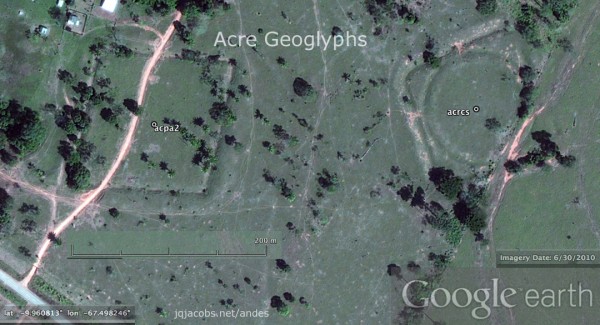By Ana Verayo, | February 07, 2017

These geoglyphs or earthworks in Acre, Brazil reveal that indigenous people preserved and maintained forests for thousands of years. (James Q. Jacobs/Google Earth)
Scientists have uncovered 450 mysterious geoglyphs or earthworks in Brazil's western Amazon. These massive geometrical land art in Acre was believed to be created by an ancient civilization around 2,000 years ago and even before European settlers arrived.
These geoglyphs remained a mystery since they were hidden in thick rainforests. Unfortunately, widespread deforestation revealed these ancient sites to make way for infrastructures and farms.
Like Us on Facebook
According to Jennifer Watling from the Museum of Archaeology and Ethnography of the University of Sao Paulo, since these sites remained hidden for centuries under mature rainforests, this discovery also questions the state of the Amazon's pristine ecosystems. Watling says that her team was eager to learn about this region since the geoglyphs were present and covered in thick and mature forest.
The team also investigated the human impact on the landscape to create these earthworks. In this new study, new analysis of the land under these geoglyph sites shows that it has been altered for thousands of years. However, these changes were never that massive or on a large scale that involved burning fields to clear the site. Indigenous groups were able to carry out small clearings where they created these earthworks and planted trees of certain species, altering the forest growth.
Watling, who is also from the University of Exeter, explains that despite multiple geoglyph sites in the hundreds around the region, the team is certain that Acre's forests are still dense. More importantly, these forests were never cleared extensively, but only in recent years.
The team also concluded that these sites served as gathering places for spiritual or religious events or celebrations. The team arrived at this conclusion since only a few artifacts have been uncovered from the earthworks.
Researchers say that these geoglyphs are strong evidence that the Amazonian forests were being maintained and managed by indigenous peoples before European colonization occurred in the region. More importantly, the study focuses on the ancient ingenuity of indigenous tribes when it comes to land use and practices, which did not lead to the degradation and destruction of the forest.
Watling says that indigenous knowledge is also crucial for sustainable land use alternatives. This new study was published in the journal, PNAS.
-
Use of Coronavirus Pandemic Drones Raises Privacy Concerns: Drones Spread Fear, Local Officials Say

-
Coronavirus Hampers The Delivery Of Lockheed Martin F-35 Stealth Fighters For 2020

-
Instagram Speeds Up Plans to Add Account Memorialization Feature Due to COVID-19 Deaths

-
NASA: Perseverance Plans to Bring 'Mars Rock' to Earth in 2031

-
600 Dead And 3,000 In The Hospital as Iranians Believed Drinking High-Concentrations of Alcohol Can Cure The Coronavirus

-
600 Dead And 3,000 In The Hospital as Iranians Believed Drinking High-Concentrations of Alcohol Can Cure The Coronavirus

-
COVID-19: Doctors, Nurses Use Virtual Reality to Learn New Skills in Treating Coronavirus Patients







